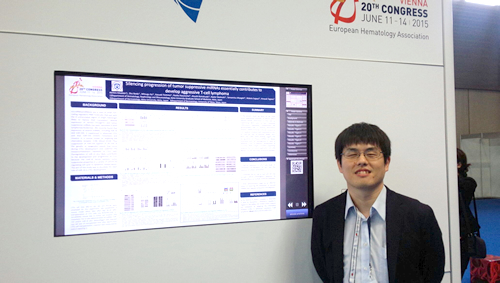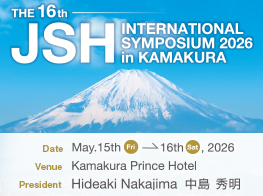
名前:北舘 明宏 【秋田大学大学院医学系研究科 血液腎臓膠原病内科学分野】
発表日時:2015年6月12日~13日
発表形式:e-poster
Title:
Silencing progression of tumor suppressive microRNAs essentially contributes to develop aggressive T-cell lymphoma
Authors:
Akihiro Kitadate1, Mitsugu Ito1, Sho Ikeda1, Kazuaki Teshima1, Naoko Hasunuma2, Tomomitsu Miyagaki3, Sugaya Makoto3, Naoto Takahashi1, Atsushi Komatuda1 , Hiroyuki Tagawa1
Affiliations:
1Department of Hematology, Nephrology, and Rheumatology, Akita University Graduate School of Medicine,
2Department of Dermatology, Akita University,
3Department of Dermatology, University of Tokyo.
Abstract
Background
Multistep genetic alterations including microRNA(miRNA/miR) are occurring during developing aggressive cancer. We have shown that some tumor suppressive miRNAs including miR-150 and miR-16 were diminished in metastatic cutaneous T-cell lymphoma (CTCL), and that miR-150 could inhibit invasion and metastasis of CTCL cells by targeting a chemokine receptor CCR6 (Blood 2014). Furthermore, we recently found that when examined expression of these miRNAs against early and advanced CTCL, miR-150 and miR-16 were decreased during disease progression. These findings suggest that dysregulation of these miRNAs is deeply associated with the pathogenesis of early to advanced CTCL.
Aims
The aim of this study was to determine the possible role of miR-16 and miR-150 in the CTCL progression.
Methods
CTCL cell lines (My-La, HH, MJ, and Hut78) were employed for this experiment. We established a mouse model which died after day 30-35 after transplantation of CTCL cells into NOD/Shi-scid IL-2 γnul(NOG) mouse due to tumor cell invasion and metastasis, namely “CTCL mouse”. For in vivo administration of miRNA, miR-150 and/or miR-16 plus atelocollagen was injected into tail vein of CTCL mice after day14 from CTCL cell transplantation. Injection was conducted by every 5 days. Results: Firstly we examined in vivo transplantation of miR-16, miR-150 stably transduced CTCL cells into NOG mice, and found that not only miR-150 but also miR-16 transduced CTCL cells injected NOG mice showed significant survival extentions than control mice. Interestingly, miR-16 transduced showed stronger tumor inhibition capability than miR-150 transduced, despite of lacking migration-inhibition capability. This result suggests that miR-16 might possess the other tumor suppressive function. Therefore we conducted functional analysis of miR-16, and found that miR-16 could lead to strong cellular senescence against CTCL cells. In miR-16 transduced CTCL cells, p21, which is a key mediator of senescence, was strongly upregulated in a p53 dependent manner. Because it has been known that Bmi-1 negatively regulates not only p16 but also p21, we examined Bmi-1 expression against miR-16 transduced CTCL cells and found its downregulation. This result suggested that miR-16 directly regulate Bmi-1 against CTCL cells leading to p21 upregulation. To examine whether Bmi-1 could directly interact promoter region of CDKN1A/p21 gene, we conducted cross-linking/chromatin immunoprecipitation (ChIP) assay against CTCL cells, and demonstrated the direct interaction. To examine whether miR-150 and/or miR-16 could lead tumor inhibition in vivo, we conducted intravenous administration of these miRNAs against CTCL mice. Though administration of either miR-16 or miR-150 extended survival of CTCL mice, use of both miR-150 and miR-16 yielded to the most survival extension because miR-150 and miR-16 cooperatively can inhibit distinct tumorigenic cascades of CTCL. Finally, we found that a histone deacetylase inhibitor, vorinostat/SAHA, led CTCL cells to induce senescence and migration inhibition with restoration of both miR-150 and miR-16, and their target proteins.
Summary/Conclusion
miR-150 and miR-16 collaborate to inhibit tumorigenic potential via down-regulating distinct tumor-associated cascades. Our findings suggest that miR-150 and miR-16 could be, at least in part, epigenetically silenced during disease progression and their restoration as well as vorinostat treatment could be key therapeutic strategy against CTCL.
EHA2015参加レポート
この度は20th EHA congress参加にあたり、日本血液学会 EHA travel awardに採択して頂き、誠にありがとうございました。
学会はオーストリアの首都ウィーンにて開催されました。ウィーンは多くの著明な音楽家を生んできたことから音楽の都として知られています。街中でバイオリンを弾いている方々を見かけたり、学会の会場前にもモーツァルトのスタイルでコンサートの案内をしている人もいたりと、ウィーンが音楽の都であることをあちらこちらで実感することができました。6月のウィーンは湿度も低く非常に過ごしやすい気候で、市内は治安もよく交通網も発達しており、大変居心地の良い街でありました。
これまでアメリカ血液学会(ASH)に参加したことはありましたが、今回私にとっては初めてのヨーロッパ訪問・EHA参加でありました。EHAはASHに比べると会場も比較的コンパクトで、プログラム構成にも余裕があり、じっくりと興味あるセッションを回ることができた印象です。今回の学会では、現在研究させて頂いている悪性リンパ腫関連の発表を中心に参加し、最新の知見を得ることができました。EHAはどちらかといえば臨床系の演題が充実している印象であり、特に慢性リンパ性白血病(CLL)の発生頻度が高いヨーロッパの学会ということもあり、CLLの新規治療薬として注目を集めているBTK阻害剤やPI3K阻害剤関連の発表の多さが目を引きました。講演の中で、“様々な新規治療薬が登場し、それらの併用など多くの臨床試験が行われていくなかで、それぞれの腫瘍のmolecular characterizationを踏まえた上でrational targeted therapyを行うべき”、というメッセージが特に印象に残り、個々のがん分子病態を詳細に明らかにしていくこと、そしてそれらを臨床に結び付けていくことの重要性を再認識することができました。
私自身は今回、皮膚T細胞リンパ腫(Cutaneous T cell lymphoma, CTCL)における癌抑制的microRNA, miR-16の機能解析とヒストン脱アセチル化酵素(HDAC)阻害剤との関わりについて発表させて頂きました。CTCLでは病勢進行に伴ってこのmiR-16の発現が低下すること、CTCL細胞のmiR-16発現を回復させると細胞老化(セネッセンス)が誘導されることを報告しました。また、CTCLに対して臨床的に有効性が示されているHDAC阻害剤がこのmiR-16の発現を回復させ、同様に細胞老化を誘導することを見出しました。細胞老化誘導にはp53の働きが必須であることがすでに示されておりますが、miR-16及びHDAC阻害剤はp53野生型細胞には細胞老化、p53変異型細胞にはアポトーシスを誘導し、全く異なった応答を導きます。HDAC阻害剤の臨床応用が他の血液腫瘍・固形腫瘍においても試みられるなかで、HDAC阻害剤が誘導するがん抑制的microRNAの詳細な機能を解明することは、治療反応予測や新たな治療標的同定にもつながると考え検討を進めているところです。
今回、EHA travel awardとして採択して頂き大変光栄に思います。現在取り組んでいる研究テーマはもちろん、他領域についても広く学ぶことができ、多くの刺激を受け研究に対する情熱を新たにすることができたように思います。このような機会を与えて頂きました日本血液学会事務局及び国際委員会の諸先生方に心より感謝申し上げます。また、日頃よりご指導頂いている田川博之先生・高橋直人教授・澤田賢一学長始め、御推薦を賜りました小松田敦先生、医局の先生方、本研究に関わって頂いた全ての皆様にこの場を借りて厚く御礼申し上げます。




